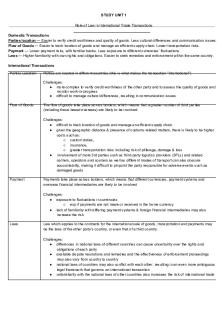EC931 International Trade: Practice Paper PDF

| Title | EC931 International Trade: Practice Paper |
|---|---|
| Course | International Trade |
| Institution | The University of Warwick |
| Pages | 2 |
| File Size | 39.3 KB |
| File Type | |
| Total Downloads | 73 |
| Total Views | 156 |
Summary
EC931 International Trade: Practice Paper...
Description
EC9310
UNIVERSITY OF WARWICK May Examinations 2019/20 International Trade
Time Allowed: 2 Hours. Answer TWO questions ONLY. All questions are of equal weight (50 marks each). Approved pocket calculators are allowed. Read carefully the instructions on the answer book provided and make sure that the particulars required are entered on each answer book. If you answer more questions than are required and do not indicate which answers should be ignored, we will mark the requisite number of answers in the order in which they appear in the answer book(s): answers beyond that number will not be considered.
1. (a) What is comparative advantage, and how can it give rise to trade flows? (20 marks) (b) If trade is driven by comparative advantage, can trade patterns be predicted on the basis of autarky price differentials? Explain. (20 marks) (c) Can the theory of comparative advantage help explain the trade patterns we observe for developed economies? Explain. (10 marks)
2. (a) With reference to the case of a small open economy, what are the welfare effects of an import tariff? (20 marks) (b) How can trade policy cooperation be sustained in the absence of a binding coordination mechanism? (20 marks) (c) Does country size matter in this respect? Explain. (10 marks)
(Continued overleaf) 1
EC9310
3. (a) What are the main predictions of a “reciprocal dumping” model of trade between two identical countries, where output in one sector is produced by a single producer in each country at a constant marginal and average cost? Explain. (25 marks) (b) Does free trade always Pareto dominate autarky on welfare grounds in this model? Explain. (15 marks) (c) Would your answer change if the two countries were not identical? Explain. (10 marks)
4. (a) Discuss how, in the presence of increasing returns to scale and product differentiation, trade can arise between similar countries and generate gains for consumers through rationalisation effects and variety effects. (20 marks) (b) Describe the ”gravity equation” representation of international trade flows, and explain its origins and predictions. (20 marks) (c) How can the gravity equation be used in empirical analysis? Explain. (10 marks)
5. (a) If trade barriers are selected by majority voting, how does the distribution of factor endowments affect policy choices? Explain. (20 marks) (b) Would your answer to part (a) change if policy choices were made in response to lobbying by interest groups? Explain. (20 marks) (c) Should we expect the interests of consumers and those of producers to carry equal weight in trade policy formation? Explain. (10 marks)
(End) 2...
Similar Free PDFs

International Trade Assignment 2
- 4 Pages

International Trade - Grade: B+
- 9 Pages

LOG305; International Trade LAW
- 39 Pages

PART 6 International Trade
- 5 Pages

International Trade Law
- 53 Pages

318 LMS - International Trade
- 2 Pages

Global International Trade Game
- 16 Pages

International Trade (Fall 18)
- 4 Pages

Summary International trade theory
- 40 Pages

International trade policy- 2122
- 78 Pages
Popular Institutions
- Tinajero National High School - Annex
- Politeknik Caltex Riau
- Yokohama City University
- SGT University
- University of Al-Qadisiyah
- Divine Word College of Vigan
- Techniek College Rotterdam
- Universidade de Santiago
- Universiti Teknologi MARA Cawangan Johor Kampus Pasir Gudang
- Poltekkes Kemenkes Yogyakarta
- Baguio City National High School
- Colegio san marcos
- preparatoria uno
- Centro de Bachillerato Tecnológico Industrial y de Servicios No. 107
- Dalian Maritime University
- Quang Trung Secondary School
- Colegio Tecnológico en Informática
- Corporación Regional de Educación Superior
- Grupo CEDVA
- Dar Al Uloom University
- Centro de Estudios Preuniversitarios de la Universidad Nacional de Ingeniería
- 上智大学
- Aakash International School, Nuna Majara
- San Felipe Neri Catholic School
- Kang Chiao International School - New Taipei City
- Misamis Occidental National High School
- Institución Educativa Escuela Normal Juan Ladrilleros
- Kolehiyo ng Pantukan
- Batanes State College
- Instituto Continental
- Sekolah Menengah Kejuruan Kesehatan Kaltara (Tarakan)
- Colegio de La Inmaculada Concepcion - Cebu





